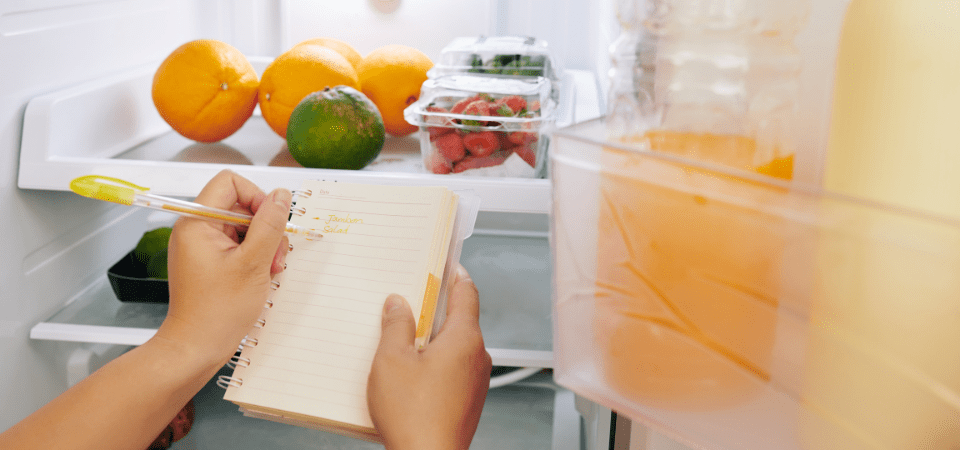According to the nonprofit organization Feeding America, Americans waste more than $218 billion each year on food, with dairy products being the food item tossed out the most. The average American family of four throws out $1,600 a year in produce.
One of the top reasons Americans waste food is they forget what they have. I know as I’ve been there before. Do you ever buy a bag of rice because you just didn’t see it in the back of your pantry? Items start to get pushed to the back where they become out-of-sight, out-of-mind.
When it comes to military moves, even when it is “paid for” by the military, it can still be an expensive process, especially when it comes to starting over in the kitchen. By better assessing what you have in your pantry, fridge, and freezer, and what items you can move, you’ll be able to better determine where it should all go and what you will need to replace.
Here are eight easy steps to save money and limit waste before moving:

STEP ONE: ASSESS WHAT YOU ALREADY HAVE
First thing first: figure out what you have. Admit it, when living in one place for a while, you tend to collect food, some of which may be hidden in the bottom of the freezer or back of the pantry. Grab a notepad and pen, and write down your inventory (i.e. what you have left in your fridge, freezer, and pantry). Place your items into several different categories, including perishables (anything in the refrigerator or freezer); canned goods (fruit, veggies, soups, legumes, etc.); non-perishables (boxes of cereal, snacks, chips, bottled water, etc.); baking and cooking supplies (flour, sugar, bread crumbs, rice, dry pasta, etc.); and anything in glass bottles (oils and dressings, alcohol, etc.). You will also want to assess what is open already since you may or may not want to reseal it and take it with you. Next to every item, write down the expiration date and/or how much longer the food will still be edible.
STEP TWO: CREATE A PLAN
After figuring out what you have and how long each item is going to stay fresh, you’ll need to decide what to do with all of it. From your list, highlight high-priority items (i.e. perishables that need to be eaten ASAP) and low-priority items (i.e. cereals, snacks, non-perishables). From there, decide what items you should try to eat before moving and what items you’ll need to donate and toss. If you’re embarking on a long-distance CONUS or OCONUS move, it might not make sense to ship or load up the car with all of your canned corn. Remember: you can always grocery shop once you arrive in your new home, but also consider your family’s favorite meals and be sure to keep items for those if they will last.
STEP THREE: EAT THE PERISHABLES
If you and your family plan to eat the contents of your fridge and freezer before moving, get creative with recipes! Not only will you save money by not going out to eat, but you’ll also save yourself the trouble of having to throw away tons of food. Be sure to get the entire family involved too! Some ideas for what to do with your food include making a pot of chili, sandwiches, pasta dishes, frittatas, stir fry, rice and veggies, breakfast meals for dinner, soups, and more.
STEP FOUR: START THE PREPARATION FOR WHAT YOU WANT TO MOVE WITH YOU
Chances are you’re going to want to bring at least a few unopened, non-perishable items with you on the move. These will save you money in the long run since you will be able to prepare some meals at your new place.
Several things to remember when preparing to pack your food:
- Use durable, resealable ziplock bags to prevent leaks and spills in the boxes and crates. This is especially important when packing items like flour, sugar, opened spices, and soups. You can also find plastic containers at your local hardware store.
- When packing glass containers, such as unopened mayonnaise, dijon mustard, jams, etc., make sure you secure them in waterproof ziplock bags and properly protect them with bubble wrap before placing them in a box.
- If you’re embarking on a CONUS move and plan to drive yourself, consider bringing a cooler with ice to store any perishables you wish to keep throughout the journey, such as fruits, veggies, milk, and more.
STEP FIVE: DONATE NON-PERISHABLE ITEMS
Any non-expired, non-perishable items, such as canned goods, rice, and pasta, that you don’t wish to bring with you should be donated to a local food bank. You can either box them up and deliver them yourself, or you can have your moving company do it for you.
STEP SIX: SHARE WITH FRIENDS AND NEIGHBORS
Have perfectly good fruit and veggies left in the fridge? Share the love with friends and neighbors. Yes, you want to save money, but as a mom of four young children, sometimes you simply can’t eat another leftover. I can promise you that there are plenty of people out there who can and will. The same goes for any alcohol or other items that the movers were not interested in. One fun idea is to throw a “clean out the fridge” or “unstock the bar” party with friends. This would be a fun PCS activity as well!
STEP SEVEN: TOSS IT
Anything that you don’t plan on eating, donating, giving to friends, or bringing with you, should be either thrown away or recycled before the move. This includes all expired foods, which you won’t be able to donate or give away anyway. Recycle all glass bottles, milk containers, and cardboard containers.
STEP EIGHT: PREPARE FOOD FOR MOVING DAY
Finally, don’t forget about the actual moving day itself! While packing and coordinating a move, there’s a good chance that you’ll get hungry at some point. You can also consider using some of the perishable items to make grab-and-go snacks, pre-made sandwiches, etc. for the movers and packers as well as your family on the big day.

